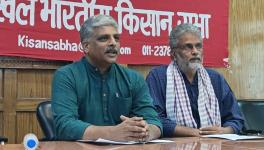Changes One Year of Agitation Has Brought in Farmers’ Life
Moradabad/Rampur/Bareilly/Pilibhit/Budaun (UP): Harendra Singh has 2.5 acre of land in his village — Manihar Khera at Bilaspur block in Rampur district of Uttar Pradesh. He had sown paddy on the entire land. Barely three days before he was about to reap the crop, torrential rain in October this year destroyed it completely. His investment was Rs 30,000.
He estimates the loss he suffered: the production on one acre of land, if the weather favoured, generally stands somewhere between 25-30 quintals. If one calculates the loss, taking into account the MSP (Minimum Support Price, which was Rs 1,940 for the common variety for the 2021-22 crop year), the total loss will settle between Rs 1.21 lakh and Rs 1.45 lakh.
Based on the general market rate (procurement price outside APMC which varies between Rs 1,200-Rs 1,300 per quintal), it would lie between Rs 75,000-81,250.
“Mind you, it is just a rough estimate wherein cost of labour, interest on expenditure and rent of land are not included,” he clarified.
Asked how he and farmers in the hinterland learned about such microeconomics of agriculture (interest on capital investment, imputed cost of capital, rent on the land, etc.), the prompt reply was: “A year-long farmers’ protest.”
Farmers from across the country have been staging peaceful sit-ins at four sites near Delhi since November 26 last year, demanding withdrawal of the three controversial agriculture laws and a legal guarantee of the MSP. Three major entry points of the national capital have been blocked since the past year.
The agitation forced the government to repeal the three legislation. Prime Minister Narendra Modi on November 19 announced that the contentious Acts would be withdrawn in the upcoming winter session of Parliament.
As the farmers’ stir set to mark one year, NewsClick spoke to farmers across several districts of poll-bound Uttar Pradesh to know the awareness and the changes the strike brought in their lives.
MSP — NOW A HOUSEHOLD NAME
A majority of farmers, including himself, claimed Harendra, did not know earlier that the MSP was their right.
“The agitation has made farmers aware of the MSP. We have now realised that the procurement of our farm yields by the government is not charity, but a right of every farmer. Though it is still far behind benefiting every farmer of the state, the footfall in APMC has substantially grown. Beyond the lip service of hiking the procurement target, the government has to do a lot and make serious attempts to fulfil its words,” he added.
Samyukta Kisan Morcha (SKM) leader Tajinder Singh Virk, who was seriously injured in the Lakhimpur Kheri incident wherein protesting farmers were allegedly run over by the cavalcade of a BJP minister’s son on October 3, said that paddy procurement in Uttar Pradesh was “disappointing.”
“The purchase began from October 1. Against the announced target of 70 lakh metric tonnes, the government has so far bought in only 4.98 lakh metric tonnes. In order to achieve the target, it was promised that 4,000 procurement centres would be set up. But only 1,712 centres are functional in the state,” he alleged while talking to this correspondent at his residence in Uttarakhand’s Rudrapur.
Given the “strict” and “unpractical” terms and conditions, and corruption, he added that farmers are left with no option but to sell their paddy at significantly lower prices, which ranges between Rs 1,250-1,350 per quintal, whereas the MSP is Rs 1,940 per quintal.
“Against the registration of 6,42,224 farmers for procurement benefits, the government has purchased paddy from only 71,352 farmers,” he said, alleging that the procurement is being denied on silly technical grounds such as moisture content in the yield and other quality parameters which farmers have no control over.
For Gurjeet Singh, who has 20 acres of land, the protest has enlightened farmers about existing government policies for their betterment. It has made them more vocal than ever.
“It was a general perception that agriculture is a loss-making business. But now everyone will explain in detail that it is actually not true but has been made so, and the credit goes to anti-farmer policies of successive governments,” Singh, whose three successive crops have been destroyed by the weather, said.
He had sown pea on five acres of land. Eight days after it was sown, rainfall destroyed the seeds completely and made him suffer a loss of Rs 75,000. He sowed it again but got little return because of the higher input cost.
Following peas, he cultivated paddy on 25 acres. Unfortunately, he faced another blow as incessant rains wreaked havoc across north India. He lost 40% of the total crop, suffering a loss of at least Rs 7.5 lakh.
He also failed to sell in the APMC the leftover paddy he reaped as it had a high content of moisture, which was brought by floodwater.
“The paddy failed to meet quality parameters for government procurement. It has moisture and a high quantity of silt, making lose its golden colour. The maximum price I have been offered outside APMC is between Rs 900-1,000 per quintal and that too after convincing the buyer. The paddy is still lying in my trolley parked at home. I am clueless about what to do,” he stated.
Sharda river, which enters Uttar Pradesh from bordering Uttarakhand, led to the flooding of several villages on its banks after water from the Sharda Banbasa barrage in Uttarakhand was released because of continuous rainfall.
Asked about the Prime Minister’s statement that ‘MSP tha, MSP hai aur MSP rahega’ (MSP was there, MSP is there and MSP will remain in the future), he said the tall claim stands fully exposed, at least in Uttar Pradesh.
Prime Minister Modi had made the promise in Rajya Sabha on February 8 this year amid the ongoing farmers’ agitation.
Singh had made a big investment in a guava orchard, but the plants failed to bear desired quantity of fruits because of adverse weather. This was his third consecutive loss.
Gurjeet has a debt burden of Rs 20 lakh, a big chunk of which he inherited from his father. “Agriculture farming is gambling and the farmer is a big gambler who borrows money either from banks or private money lenders to invest it on their crops. If it gets destroyed, he has to borrow additional sums from other lenders to pay interest for the previous loan. If the second crop fails, which often happens, he is left with no option but to sell his land and stop farming or commit suicide. Selling land is considered a social stigma; therefore, indebted people prefer to end their lives,” he said, talking to NewsClick near his orchard in Bilaspur.
Amir Ahmad, a 52-year-old farmer from Devapur village in Rampur district, too reiterated that the ongoing farmers’ strike had made him realise the nitty-gritty of the MSP and how agricultural farming has “systematically” been made a loss-making business to “turn farmers into skilled labourers of corporates.”
“We had accepted losses after losses due to crop failures, mounting debt and rising poverty as our fate. But the agitation made us realise what the MSP is and how farming is systematically being turned into an unprofitable affair. There are several takeaways from this protest. It has also made us realise that strong determination, resilience and not bowing to the situation are the key to success,” he added.
He said that the government is making tall claims of hiking the procurement, but the reality is farmers are forced to sell their crops in the open market at a price much lower than the MSP.
“I had sown paddy on two acres of land, but the rains completely destroyed 90% of the crop. Against the expected yield of at least 35 quintals, the production was just 3.5 quintals. After the government-appointed centre refused to buy, I had to sell it to a trader at Rs 1,500 per quintal,” he narrated.
He further said selling crops on MSP in the APMC is not as simple as taking the produce there and selling it. One has to follow a complex and exhaustive official process for the same. The farmer has to get himself registered with the tehsil having jurisdiction of his area at least two months before the procurement starts. The application follows an intense verification process, which takes at least 20 days.
Finally, the applicant is issued a registration number. Following their registration with their tehsil, farmers go to the government procurement centre, which issues them their serial number and date of procurement.
This is not all he has to go through, said Ahmad, alleging that as the farmer reaches the procurement centre on the given day with his yield, the centre in-charge raises several objections on technical grounds such as quality of the product etc, perhaps to force him to sell the product in private mandis.
“Those who manage to sell their product at the government centre get payment of 95 kilogram instead of 100 kilogram. It is basically corruption where farmers are robbed of their hard-earned money if he wants to sell it on the MSP,” he alleged and added, “Therefore, farmers have to sell their products to private traders, who make instant payment against cash. Though they suffer a loss, they save transportation costs, etc. Government procurement is done for a fixed period of time. As it expires, the rate of the product in the market drastically go down,” he explained.
RESTORATION, HIKE OF SUBSIDY FOR FERTILIZER
The Centre in April 2020 had reduced subsidy for nitrogen-based fertilizers to Rs 18.78 per kilogram and phosphorous-based fertilizers to Rs 14.88 per kilogram. However, fearing protests over fertiliser prices, the government later not only withdrew the decision but also increased the subsidy on di-ammonium phosphate (DAP) by 137% to Rs 1,211.55 from Rs 511.55 per 50-kilogram bag.
Even after fertiliser manufacturers had hiked retail prices, political compulsions led to the move.
RE-ENGAGING YOUTH IN AGRICULTURE
Unable to find a meaningful, stable and well-paying source of income, young people in large numbers were losing interest in farming — threatening the agriculture sector. They were migrating to big cities and going abroad for jobs.
Twenty-seven-year-old Manveer Singh, who is a postgraduate in information technology and hails from Baheri in Bareilly, dropped the offer of serving a US-based company as a system analyst after actively taking part in farmers’ protests at the Delhi-UP Ghazipur border. He turned to farming, refusing a job that would pay a modest wage.
“After my education, I tried to get a white-collar job and got one. As I was about to join the firm, the protest began, and I started frequenting Ghazipur and Singhu borders. After listening to farmer leaders, I researched the agriculture economy and found it more profitable if it was using modern technology. I also realised that the government brought the new laws just to destroy the sector so that big corporates can be supplied with cheap labour. I decided to take a plunge in agricultural farming instead of serving a big firm, where there is job security,” the young man, who defies the typical image of a farmer, told NewsClick.
Kulwinder Singh, who belongs to Puranpur in Pilibhit, wanted to shift to Canada. But he junked the idea as the protest began. The 32-year-old has 40 acres of land, which he says is enough to sustain his family.
“The loss of livelihoods during the pandemic has made me insecure. We have such a huge population that we and even our future generations have no hopes of finding a job. Our successive governments have failed to create enough non-farming jobs for a country where two-thirds of the 1.3 billion population is under 35. So, it is better to work on the farmland instead of going anywhere,” he added.
Get the latest reports & analysis with people's perspective on Protests, movements & deep analytical videos, discussions of the current affairs in your Telegram app. Subscribe to NewsClick's Telegram channel & get Real-Time updates on stories, as they get published on our website.
























